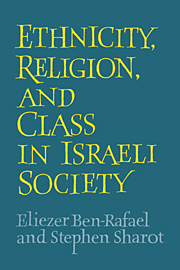Book contents
- Frontmatter
- Contents
- Acknowledgments
- I Theoretical and empirical background
- II Social patterns and behavior
- 5 Neighborhoods: synagogues and neighborhood committees
- 6 Religiosity and secularization
- 7 Friendship networks
- III Identities and images
- IV The impact of stratification
- V Social cleavages: an overview of Israeli society and some theoretical implications
- Appendix A The sample
- Appendix B Deprivation index
- Appendix C Indexes of ethnic identification
- Glossary
- Notes
- References
- Index
5 - Neighborhoods: synagogues and neighborhood committees
Published online by Cambridge University Press: 12 September 2009
- Frontmatter
- Contents
- Acknowledgments
- I Theoretical and empirical background
- II Social patterns and behavior
- 5 Neighborhoods: synagogues and neighborhood committees
- 6 Religiosity and secularization
- 7 Friendship networks
- III Identities and images
- IV The impact of stratification
- V Social cleavages: an overview of Israeli society and some theoretical implications
- Appendix A The sample
- Appendix B Deprivation index
- Appendix C Indexes of ethnic identification
- Glossary
- Notes
- References
- Index
Summary
In the 1950s Middle Eastern and European groups of origin in Beer Sheva founded ethnic organizations which provided both contexts of sociability and material help, such as small loans, for their members. Over time these organizations lost their instrumental functions to state, municipal, and other public agencies, and as contexts for social interaction, they held little appeal for the younger generation who grew up in Israel. Ethnic organizations or Landsmannschaften are far less important today, but the ethnic synagogue has remained important among Middle Easterners.
As in other countries of immigration, such as the United States, the ethnic religious congregations provided a medium for the continuation of traditional religious practices and a center for the social interaction of members whose common origins, native language or dialect, and common cultural and social patterns provided important bases for the comforting and familiar patterns of communication and community. However, in the United States most ethnic churches and synagogues did not last beyond the first generation, and the second generation tended to reject the traditional ethnic culture of their parents and to join interethnic congregations along denominational lines (Herberg, 1960). Since more than half the adult population of Israel was born or socialized in the country, it is now possible to investigate whether a similar process of de-ethnization of religion is occurring in Israel.
- Type
- Chapter
- Information
- Ethnicity, Religion and Class in Israeli Society , pp. 75 - 86Publisher: Cambridge University PressPrint publication year: 1991

